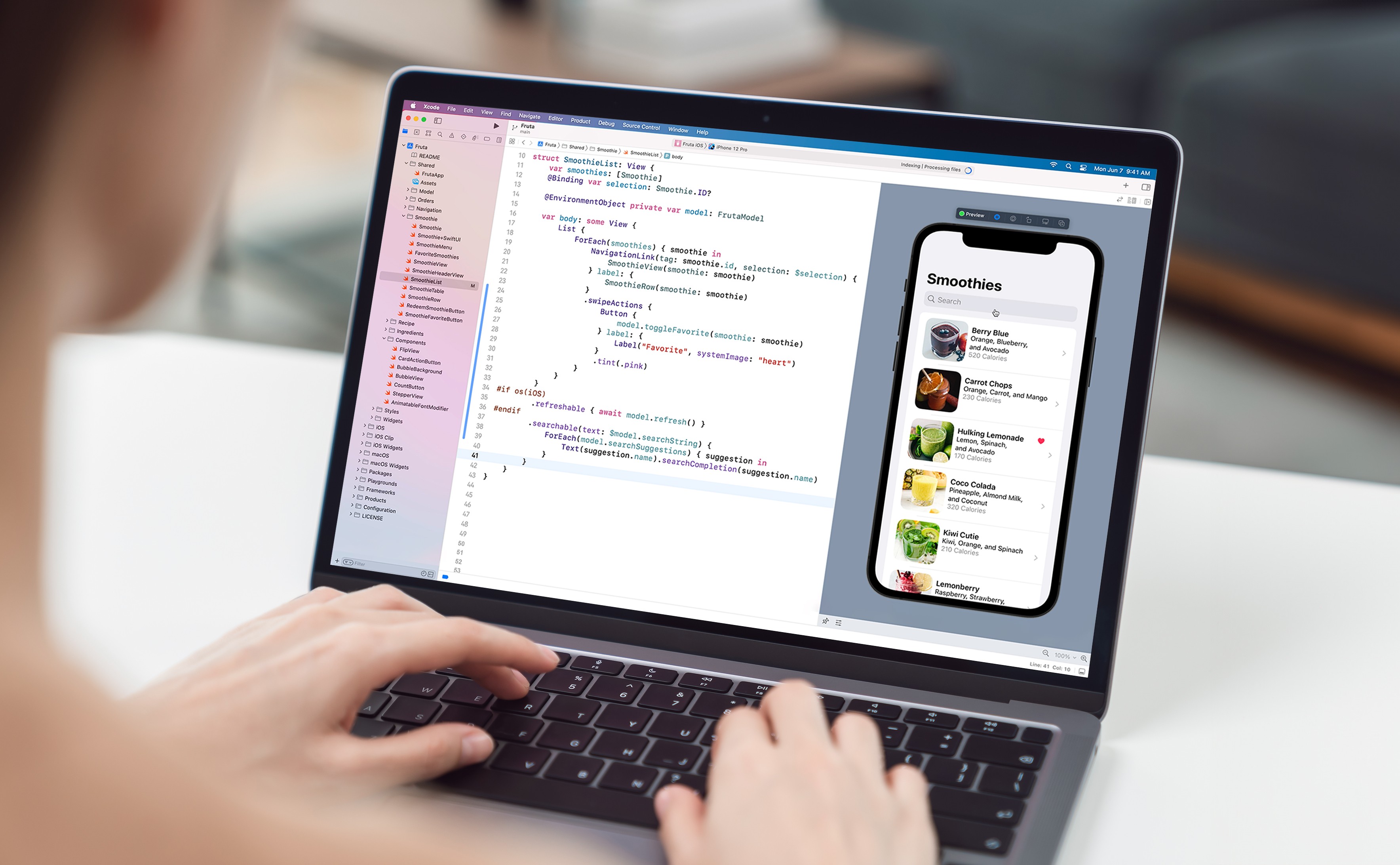The Best Programming Languages & Platforms for iOS App Development

In 2021, the internet was accessed by over 4.32 billion unique mobile devices, meaning that the majority of internet traffic was from mobiles. Ever since mobile phones were launched, the mobile market has kept growing at a rapid pace, with no signs of a slowdown. Apple launched the first iPhone in 2007; today, there are over 1 billion iOS devices in the world, and more than 1.5 million apps in the App Store. This shows how important iOS development is.
It is imperative that the right iOS app development language is selected so that the development can proceed smoothly, the app performance is good, and it’s easy to maintain.
What Is iOS Programming Language?
iOS programming languages are the ones used to make apps for Apple devices like iPads and iPhones. The most popular iOS language is Swift and SwiftUI, followed by Flutter, React Native, Objective-C and other languages.
Swift UI has the number one spot, but Objective-C is not done and dusted yet. It’s used whenever legacy codebases are involved, for existing or new projects. All iOS developers can use both languages in the same project, so that they can have a smooth transition, gradually shifting to Swift, rather than a sudden change.
The Most Popular iOS App Development Languages and Platforms
Objective-C
Objective-C was developed in the early 1980s and was the chief programming language for all Apple devices for years. It’s derived from C and is an OOPL or Object-Oriented Programming Language that focuses on relaying messages to different processes rather than invoking processes as in C. Though it is considered outdated as an iOS coding language now, it is still used by many developers, especially to work on older codebases or to provide support for legacy devices. Objective-C with UIKit remains a practical and effective option for iOS app development companies and developers.
Features of Objective-C
- It is a complex and mature language
- Backward compatibility is available as it supports older iOS versions
When to Use
Objective-C is the best iOS app development language to code new iOS apps if you want them to operate on older iOS versions, and to update and maintain older iOS applications. Many pre-installed apps and iOS itself use Objective-C.
Pros of Objective-C
- Backward compatibility with C and C++
- Compatibility with older iOS operating systems
- Large community and developer support
- Supports wide range of third-party libraries and frameworks
Cons of Objective-C
- Complexity of syntax makes it difficult to learn
- Necessitates maintaining two files of code for header and implementation
- Security vulnerabilities
Swift
Swift simplifies the creation of user interfaces across all Apple platforms using Swift's power, offering an innovative approach. Swift is the most popular iOS development language today; SwiftUI serves as a user interface toolkit employed for designing apps in a declarative manner. Developers can leverage SwiftUI to create visually appealing and interactive user interfaces for their iOS applications.
While quite similar to its predecessor Objective-C, its syntax is simpler, and it stresses more on security. With Swift, you can incorporate legacy code into apps that you update, as it has the same runtime as Objective-C. Its simplicity makes it easy for newbies to learn and program, and easy to use as well. Swift enjoys the full backing of Apple as it was created by the company, and optimised for building apps for all Apple devices.
Features of Swift
- Simple, flexible, and intuitive code
- Enables functions to generate more values than one easily
- Uses ARC or Automatic Reference Counting to delete instances not in use
- Allows the use of types as parameters, helping generics to detect programming errors
- Delivers native app experience
- Works seamlessly with Apple’s Cocoa and Cocoa Touch frameworks to build feature-packed iOS apps complete with graphics, interfaces, databases,etc.
When to Use
Ideally, Swift should be used whenever you want to build a native iOS application as it allows you to leverage iPhone features to the maximum. It is also useful for expanding older iOS apps as Swift is interoperable with the legacy files of Objective-C. LinkedIn is an iOS app built using Swift.
Pros of Swift
- Quick and lightweight
- Open-source
- Syntax is simple and easy to learn
- Inbuilt safeguards help prevent errors
- Uses minimal memory
- Enables maximum use of iOS features and iPhone hardware
- Quick scaling
- Unified codebase
- Large user and developer community
- Continuous updating and improvements by Apple to enable support for new iOS features
Cons of Swift
- May face issues with third-party APIs
- No support for Android development
- May face issues with version compatibility
- Does not work on iOS versions older than 7.0
- Inadequate cross-platform support
WAC is a digital transformation company with a whizz team of Swift developers who are capable of turning your ideas into reality with engaging, high-performing, and appealing iOS apps that become your revenue generating engines.
Flutter
Developed by Google and launched in 2017, Flutter is highly popular for iOS language programming. This highly versatile open-source language is used to create apps in iOS, Android, Windows, and others. Developers can build visually appealing and user-friendly cross-platform apps. As it’s comparatively new, the language has a younger and limited talent pool.
Features of Flutter
- Quick compilation without impacting code quality
- Consistent rendering on iOS and Android
- Rapid app creation
- Easy code maintenance as same language can be used to build apps for both platforms
- Uses the relatively easier Dart language
- It’s compiler is high performing and supports hardware acceleration
- Supports C, C++, and Objective-C
- Enables writing scripts with garbage collection and other automated memory management functions
- Can be used by data types controlled by garbage collection
When to Use
Flutter is the hottest cross-platform app development language today, and it’s ideal when you want to have different versions of the same app, like in iOS, Windows, Android, etc. You can use the same codebase to create apps for all operating systems that are compatible.
Pros of Flutter
- Easy learning curve, especially for those who know JavaScript
- Same codebase for iOS and Android development
- Quicker than JS
- Offers support for a wide range of devices and screen sizes
- Easy to instantly make changes in the app, especially useful while bug fixing
- Smooth performance ensures exceptional user experience
- Faster QA and testing
Cons of Flutter
- Young programming language, used by only a few developers
- Limited community and support
- Apps made in Flutter cannot be lightweight
- No browser support currently, so web apps are not possible
React Native
A Meta product, React Native is quite popular as a language for iOS app development. Being simple to learn, it is popular among programmers for developing iOS and Android apps. React Native is popular across industry verticals.
Features of React Native
- Supports flexbox and auto layout, facilitating the creation of responsive layouts
- Enables development of native cross-platform mobile apps using single code for iOS and Android
- React Native focuses on components; they are capable of communication
- There are several third-party tools that can be used for numerous purposes
When to Use
Whenever you want to create a simple app and don’t use native features not accessible in React Native, have an existing team with the expertise, and/or want to build a team capable of working on mobile and web app development at the same time - is ideal for using this language.
Pros of React Native
- Cross-platform support
- Rapid development
- Quick deployment
- Speedy bug fixing
- Simplified user interface
- High performance
- Built on JavaScript
- Large community and support
- Fast refresh
Cons of React Native
- Complex language not easy to learn
- Issues in upgrading
- Limited compatibility
- No custom modules available
- Dependence on native code
C#
C# enables cross-platform code sharing with Xamarin and other tools, allowing developers to build native iOS apps while reusing substantial logic from other projects. It is useful as a language for programming for iOS apps which require more versatility. With Xamarin, C# code can be shared across iOS, Android, and Windows platforms, thanks to its ability to compile C# code into native binaries for each platform, while still providing access to platform-specific APIs.
Features of C#
- C# handles mistakes rationally and in a structured manner, providing protection against errors.
- Capable of handling low-level memory management
- Strongly supports OOP and offers classes
- Uses Generics which helps meet the app area in need of change
- Combines usage of several programming languages into one
- Despite lower speed, it’s life cycle is longer thanks to Microsoft support
When to use
C# is ideal for developing versions of existing iOS apps like for Android, Windows, Web API etc., and when you have experienced C# developers.
Pros of C#
- Feature-rich language enables development of complex apps
- Large community of developers and robust ecosystem of frameworks and libraries
- Low maintenance cost thanks to write once, deploy everywhere feature
- High -performing
- Open source
- Cross-platform support
- Scalable and capable of being updated
Cons of C#
- Challenging to learn
- Being based on the .NET framework of Microsoft, it is not highly flexible
- Requires third-party frameworks like Xamarin for iOS development
Requirements for the iOS App Development Process
What are the things you need to have before you even start coding?
- A Mac with the newest macOS version
- XCODE, the IDE for macOS (free download from App Store)
- Active Apple Developer account, charged at 99 USD annually
These three work in combination; you need to be an active member of the Apple Developer program, and your apps must be signed and published by Xcode; since it only runs on macOS, which only runs on Apple Mac computers. Xcode includes a code editor, UI designer, asset catalogue and testing engine; in short, everything that you would need to develop iOS apps.
The Major Benefits of iOS Programming Languages For Businesses
iOS programming offers innumerable benefits for businesses; let’s look at the key points:
- High Performance - as they are compiled into native code, they offer top notch performance
- Constant Updates - Swift is continuously updated by Apple, which means apps will keep supporting the latest iOS versions
- Wider Reach - using languages to build cross-platform apps increase user base as compared to building for a single platform
- Cost-effective - using a single code across platforms reduces effort and resources required to build and update apps in both platforms
Conclusion
As Apple continues to lead the smartphone market, the demand for iOS apps is set to rise, creating a strong need for skilled developers. Choosing the right programming language is essential for an efficient development process. For high-performing iOS applications, collaborating with a reputable iPhone app development company is key. As a trusted iOS development company, we are here to help you bring your app ideas to life. If you're looking for expert iOS developers to build your next app, hire ios programmer from our team today.
FAQ

Futuristic iOS App Development Services
Get cutting-edge app development solutions to build the iOS mobile applications for an intuitive user experience
- Best iOS Architecture Patterns for Your App’s Success
- React Native vs Swift: Which one should you choose for iOS app development?
- SwiftUI vs UIKit: Which iOS UI Framework Should You Choose in 2025
- Swift Vs. Objective-C: Which is the Best Option for the 2025 iOS App Development?
- Top iOS App Development Trends for 2025
Discover Digital Transformation
Please feel free to share your thoughts and we can discuss it over a cup of tea.










